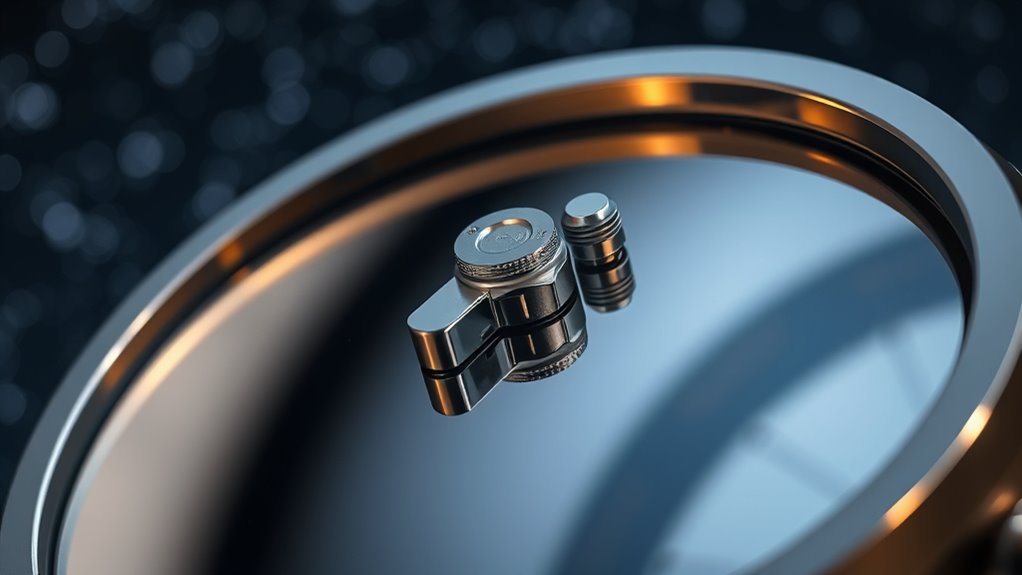If you’re looking for the 15 best telescope collimation tools for perfect alignment in 2025, I recommend a mix of laser collimators like the Astromania and SVBONY models, along with traditional Cheshire eyepieces such as Celestron’s. These tools offer precise, easy-to-use options for aligning your mirrors and optics. From durable laser tools to adjustable crosshairs, there’s something for every telescope type. Keep exploring, and you’ll discover the best options to optimize your stargazing experience.
Key Takeaways
- The top collimation tools include laser collimators, Cheshire eyepieces, and adjustable artificial star devices for precise alignment.
- High-quality models feature durable metal construction, fine adjustment options, and compatibility with various telescope sizes and types.
- Laser collimators provide quick, accurate setup, while traditional tools like Cheshire provide detailed mirror alignment.
- Advanced options include sealed calibration openings, adjustable brightness, and CNC-machined components for professional-grade precision.
- Choosing the right tool depends on telescope type, user experience, and desired accuracy for optimal performance in 2025.
Astromania Laser Collimator for Newtonian Telescopes
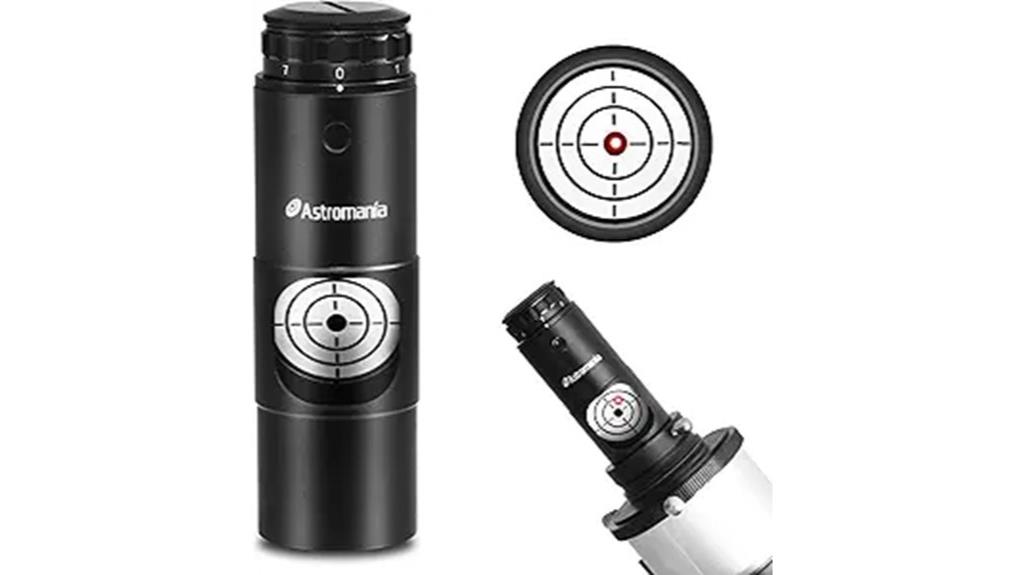
If you’re looking for a reliable tool to achieve perfect collimation in your Newtonian telescope, the Astromania Laser Collimator is an excellent choice. It fits standard 1.25-inch focusers, making setup quick and straightforward. Fully adjustable with three openings at 120°, it guarantees precise alignment. The laser emits a safe, bright red beam with seven brightness settings, helping you fine-tune your telescope easily. Crafted from durable anodized aluminum, it’s built to last. Fully calibrated and simple to use, it saves time and improves image clarity. Powered by a common CR2032 battery, it’s lightweight and portable—perfect for both beginners and experienced astronomers.
Best For: Amateur and professional astronomers seeking quick, precise collimation of their Newtonian telescopes with a durable, easy-to-use laser tool.
Pros:
- Fully adjustable with three openings at 120° for precise alignment
- Bright red laser with seven adjustable brightness levels for easy visibility
- Constructed from durable anodized aluminum, ensuring long-term use
Cons:
- Requires removal of rear screw cap for initial setup, which may be slightly inconvenient
- Powered by a CR2032 battery not included, so an extra purchase is needed
- Slight calibration adjustments may be necessary over time for optimal accuracy
SVBONY Red Laser Collimator for Newtonian Telescope Alignment

The SVBONY Red Laser Collimator stands out as an excellent choice for amateur astronomers seeking quick, precise alignment of their Newtonian telescopes. It’s compatible with both 1.25-inch and 2-inch scopes, featuring a removable adapter for easy upgrades. Its solid metal body ensures durability, while the triple cemented lens delivers stability and accuracy. The laser provides seven adjustable brightness levels, making it versatile for various lighting conditions. Setup is straightforward, and the included instructions simplify the collimation process. Rated highly by users, it offers fast, reliable alignment, helping me achieve clearer images and better viewing experiences with minimal effort.
Best For: amateur astronomers seeking a fast, precise, and durable laser collimator for aligning Newtonian telescopes of 1.25-inch and 2-inch diameters.
Pros:
- Easy and quick setup with clear, step-by-step instructions.
- Durable solid metal body ensures long-term use.
- Adjustable brightness levels improve visibility in various lighting conditions.
Cons:
- May be less suitable for very large or specialized telescopes outside the compatible sizes.
- Slightly heavier compared to simpler collimator models, which could affect portability.
- Limited to red laser alignment, which might not suit those preferring other laser colors.
Celestron 94182 Cheshire 1.25 inch Collimation Eyepiece, Black

For astronomers seeking precise and reliable telescope collimation, the Celestron 94182 Cheshire 1.25-inch Collimation Eyepiece stands out as an excellent choice. Designed for 1.25-inch focusers and diagonals, it’s perfect for aligning Newtonian and Schmidt-Cassegrain telescopes. Its simple yet effective design features a small opening and thin crosshairs, making alignment straightforward. The durable build ensures long-lasting performance, while the high accuracy helps maximize image sharpness and resolution. At just 4.8 ounces, it’s lightweight and easy to handle. With a solid reputation and a two-year warranty, this tool is a must-have for achieving ideal telescope performance.
Best For: amateur and professional astronomers seeking precise telescope collimation for optimal image clarity and performance.
Pros:
- Highly accurate collimation tool improves optical alignment and image sharpness
- Easy-to-use design with clear crosshairs simplifies alignment process
- Durable construction ensures long-term reliability and consistent performance
Cons:
- Only compatible with 1.25-inch focusers and diagonals, limiting versatility
- Slightly more expensive than basic collimation tools
- Requires some familiarity with telescope adjustments for optimal use
Astromania Laser Collimator for Newtonian Telescopes

When aiming for precise alignment of your Newtonian telescope, the Astromania Laser Collimator stands out thanks to its adjustable laser beam and compatibility with both 1.25-inch and 2-inch focusers. I appreciate its removable 2-inch adapter, making it versatile for various setups. The laser emits a bright red beam with multiple brightness levels, ensuring visibility in different conditions. It’s fully adjustable, allowing me to fine-tune the collimation quickly, guided by clear instructions in English and German. Its durable metal construction guarantees longevity, and the simple calibration openings help achieve perfect alignment, ultimately enhancing my telescope’s image clarity and performance.
Best For: Amateur astronomers and telescope enthusiasts seeking quick, precise collimation of Newtonian telescopes with easy-to-use, adjustable laser tools.
Pros:
- Fully adjustable laser beam for precise alignment
- Compatible with both 1.25-inch and 2-inch focusers, including removable adapter
- Durable metal construction ensures long-term use and reliability
Cons:
- Requires a CR2032 Lithium Cell battery (not included) for operation
- Calibration openings are initially sealed, requiring manual adjustment for fine-tuning
- May need careful handling to maintain calibration over time
SVBONY SV197 Collimating Cheshire Eyepiece for Newtonian Telescopes

If you’re seeking precise, reliable collimation for your Newtonian telescope, the SVBONY SV197 Collimating Cheshire Eyepiece stands out as an excellent choice. Its 1.25-inch design is compatible with Newtonian and SCT reflector telescopes, as well as refractors. Made from durable, precision-machined aluminum, it features fine crosshairs and a bright mirror for clear sighting. The peephole allows direct visualization, making secondary mirror adjustments straightforward. You don’t need batteries, and it works both during the day and at night. Overall, this tool offers accurate, easy collimation, helping you achieve optimal telescope performance with minimal fuss.
Best For: amateur astronomers and professionals seeking precise, reliable collimation of Newtonian, SCT reflector, and refractor telescopes for optimal optical performance.
Pros:
- Easy to use with no batteries required for quick, accurate alignment
- Durable, precision-machined aluminum construction for long-lasting use
- Bright, clear mirror and fine crosshairs enhance sighting accuracy
Cons:
- May require some familiarity with collimation procedures for beginners
- Designed specifically for 1.25-inch telescope accessories, limiting compatibility with larger eyepieces
- Can be less effective in extremely bright lighting conditions without additional shading
SVBONY SV121 Red Laser Collimator for Telescopes

The SVBONY SV121 Red Laser Collimator stands out as an ideal choice for amateur astronomers and hobbyists seeking precise, straightforward telescope alignment. Its adjustable design works with Newtonian and Dobsonian telescopes, compatible with both 1.25-inch and 2-inch adapters. The collimator features a high-quality spherical module with glued optical glass lenses, producing a clear, stable laser spot for accurate alignment. Made from durable CNC-machined metal, it resists temperature fluctuations, even in extreme cold. Easy to calibrate with a hex wrench, it simplifies collimation, reducing manual adjustments. Overall, the SV121 offers reliable performance and robust construction for precise telescope setup.
Best For: amateur astronomers and hobbyists seeking precise, easy-to-use telescope alignment tools for Newtonian and Dobsonian telescopes.
Pros:
- Adjustable design compatible with 1.25-inch and 2-inch adapters for versatile use
- High-quality spherical optical module ensures stable, clear laser spots for accurate collimation
- Durable full metal construction resists temperature fluctuations, suitable for cold-weather astronomy
Cons:
- Slightly higher price point compared to basic collimators
- Requires calibration with a hex wrench, which may be inconvenient for some users
- Limited to laser collimation, not suitable for all types of telescope adjustments
Alstar Red Laser Collimator for Newtonian Telescopes

The Alstar Red Laser Collimator stands out as an excellent choice for amateur astronomers seeking quick, precise alignment of their Newtonian telescopes. It’s compatible with all 1.25-inch focusers and features a laser with a wavelength of 635 to 655 nm, outputting less than 5 mW. Made from durable metal, it offers stability and longevity. The laser’s brightness is adjustable across seven levels, ensuring clear visibility in various lighting conditions. With three adjustment openings at 120 degrees, it allows precise calibration. Easy to operate, it’s powered by a CR2032 battery, making alignment straightforward for both beginners and experienced users.
Best For: amateur astronomers and hobbyists seeking quick, precise telescope collimation for Newtonian reflectors with easy-to-use features.
Pros:
- Compatible with all 1.25-inch focusers for versatile use
- Adjustable brightness levels for clear visibility in various lighting conditions
- Durable metal construction ensures stability and long-lasting performance
Cons:
- Requires a CR2032 battery (not included), which needs to be purchased separately
- Adjustment openings are sealed initially and require access for calibration, potentially challenging for some users
- Laser power is below 5 mW, which may limit the brightness for very bright outdoor environments
1.25 Inch Collimation Eyepiece with Cross Hair for Newtonian Telescopes

Designed specifically for Newtonian telescopes, the 5 Inch Collimation Eyepiece with Cross Hair offers precise alignment thanks to its long, cross-hair reticle. It fits into 1.25-inch focusers or diagonals, making it versatile and easy to use. The CNC-machined surfaces ensure high accuracy, outperforming basic tools. Its durable, dustproof, and moisture-proof rubber cover protects it during storage and transport. I find it especially helpful for fine adjustments, improving collimation accuracy. At just 1.6 ounces, it’s lightweight yet robust, providing reliable performance. This eyepiece is an excellent choice for both amateur and professional astronomers seeking precise, straightforward telescope alignment.
Best For: amateur and professional astronomers seeking precise and easy telescope collimation for Newtonian telescopes.
Pros:
- Highly accurate due to CNC-machined surfaces and long cross-hair reticle
- Fits easily into 1.25-inch focusers or diagonals for versatility
- Durable and protected with dustproof and moisture-proof rubber cover
Cons:
- Price and availability may vary across different stores
- Requires careful handling to maintain precision due to small size and delicate surfaces
- May be more advanced for beginners unfamiliar with collimation tools
NEEWER Red Laser Collimator for Telescopes

If you’re serious about achieving pinpoint accuracy in telescope alignment, the NEEWER Red Laser Collimator stands out with its precise laser dot and easy adjustment features. Designed for reflector telescopes like Newtonian and Schmidt-Cassegrain models, it offers reliable compatibility through its 2-inch adapter. The laser emits a sharp, clear red dot, and the side window at 45° helps verify reflection accuracy. With three accessible adjustment points and a sturdy aluminum alloy build, it’s lightweight and durable, even in extreme weather conditions. I find it straightforward to use, and its consistent performance ensures precise collimation, making it a valuable tool for perfect telescope alignment.
Best For: amateur and professional astronomers seeking precise telescope alignment and easy collimation of reflector telescopes like Newtonian and Schmidt-Cassegrain models.
Pros:
- Emits a sharp, clear red laser dot for high precision.
- Features three adjustable points for effortless and accurate alignment.
- Constructed from durable aluminum alloy, lightweight, and weather-resistant.
Cons:
- Only offers a single brightness level, limiting brightness adjustment options.
- Requires a CR2032 battery, which may need replacement over time.
- Designed specifically for reflector telescopes; not compatible with refractors or other types.
1.25 Inch Collimation Eyepiece with Cross Hair for Newtonian Telescopes
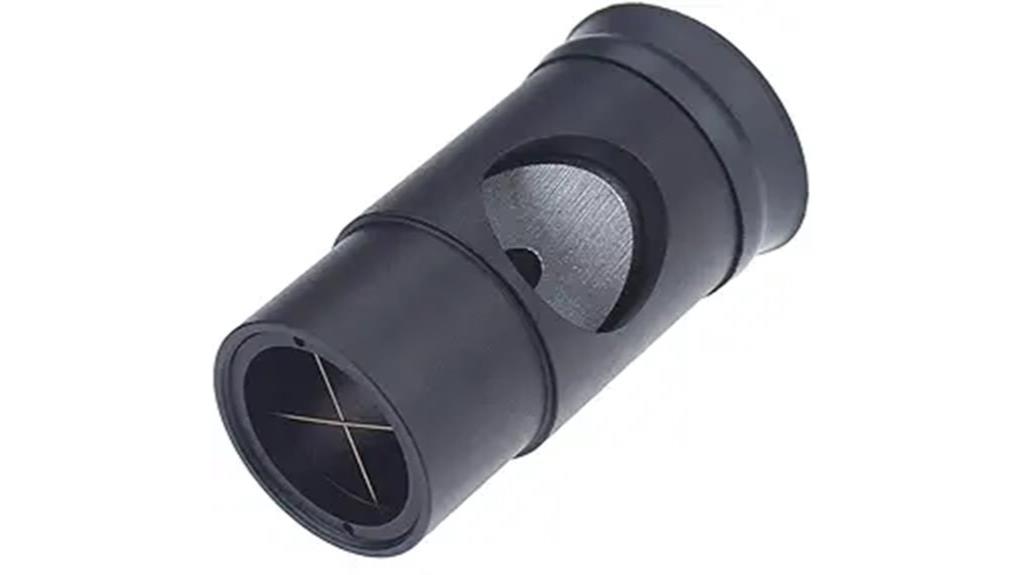
A 5-inch collimation eyepiece with crosshair offers precise mirror alignment for Newtonian telescopes, making it an essential tool for both beginners and experienced astronomers. Designed specifically for 1.25-inch focusers and diagonals, it simplifies aligning primary and secondary mirrors to guarantee ideal image quality. Its 45-degree plate allows for easier, more accurate adjustments, while the CNC-machined construction guarantees high precision. The dustproof and moisture-proof rubber cover enhances durability. Using this eyepiece markedly improves telescope performance, reduces collimation time, and delivers sharper, clearer views—making it a must-have for anyone serious about perfect alignment.
Best For: both amateur and professional astronomers seeking precise mirror alignment in Newtonian telescopes to enhance image clarity and observational accuracy.
Pros:
- Facilitates highly accurate collimation of primary and secondary mirrors
- Features a 45-degree plate for convenient, easy adjustments during setup
- CNC-machined construction ensures high precision and durability
Cons:
- Designed specifically for 1.25-inch focusers, limiting compatibility with other sizes
- May require some experience to achieve optimal alignment results
- Slightly higher cost compared to basic collimation tools
Alstar Laser Collimator 1.25 for Newtonian Telescopes
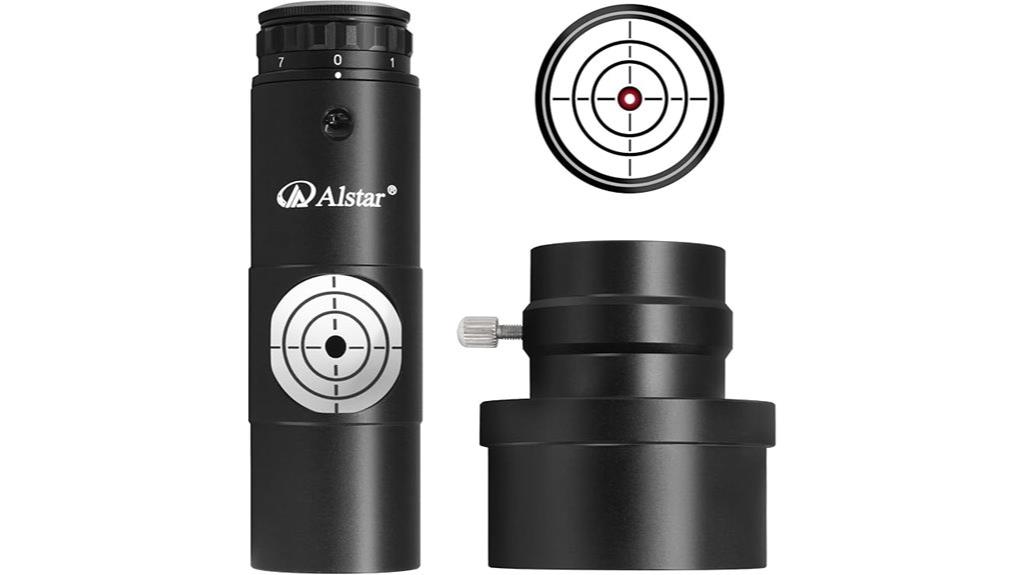
The Alstar Laser Collimator 1.25 stands out as an excellent choice for amateur astronomers seeking quick, precise collimation of their Newtonian telescopes. Its compatibility with standard 1.25-inch and 2-inch focusers makes it versatile and easy to use. The laser is pre-adjusted and features sealed adjustment openings for fine-tuning if needed. With a durable metal build and adjustable brightness, it ensures reliable performance and clear visibility. The included reflection verification system guarantees accurate alignment. Powered by a simple-to-replace CR2032 battery, this tool allows for straightforward, one-person operation, making telescope collimation faster and more accurate.
Best For: amateur astronomers, including beginners, seeking quick and precise collimation of Newtonian telescopes with standard focusers.
Pros:
- Fully pre-adjusted laser ensures easy setup and use
- Compatible with 1.25-inch and 2-inch focusers for versatility
- Durable metal construction and adjustable brightness for reliable performance
Cons:
- Battery not included, requiring a separate purchase of CR2032 cell
- Sealed adjustment openings may be limited in fine-tuning compared to fully accessible screws
- Laser output below 5 mW, which may be less bright in very bright conditions
Alstar 1.25-Inch Metal Collimating Eyepiece for Newtonian Telescopes
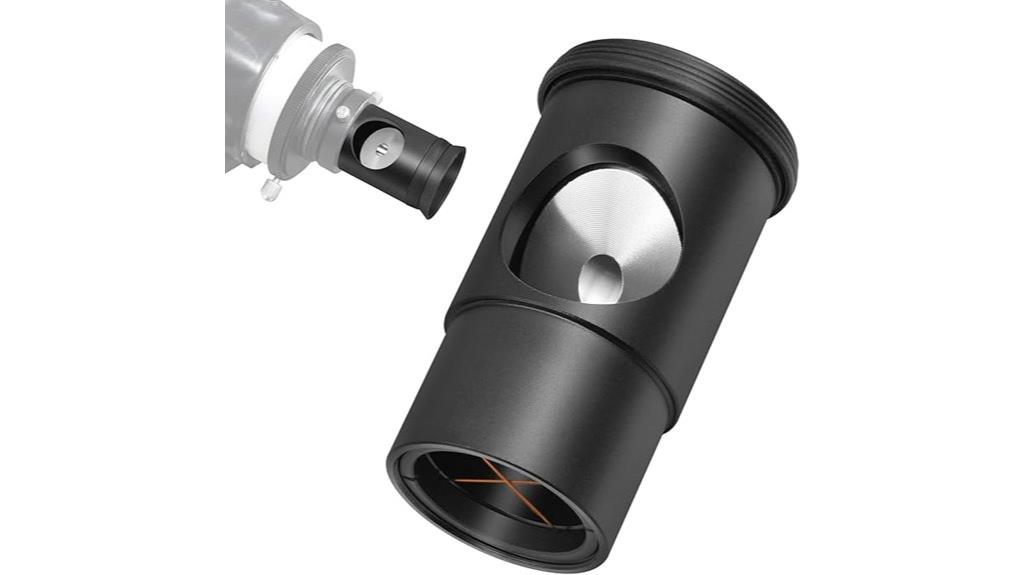
Designed for both beginner and experienced astronomers, the Alstar 1.25-Inch Metal Collimating Eyepiece offers precise alignment for Newtonian telescopes. Made from durable aluminum alloy, it features a 45-degree plate for easy visual checks and a crosshair at the bottom for quick centering of optics. To use, just remove the diagonal, cap the telescope, and insert the eyepiece—no complex adjustments needed. It guarantees accurate collimation, resulting in sharper stars and clearer planetary details. This tool boosts confidence in your alignment process and notably improves your viewing experience, making it an essential addition to any astronomer’s toolkit.
Best For: both beginner and experienced astronomers seeking precise and easy collimation of their Newtonian or Schmidt-Cassegrain telescopes.
Pros:
- Made from durable aluminum alloy for long-lasting use
- Features a 45-degree plate for comfortable visual alignment
- Equipped with a crosshair for quick and accurate centering of optics
Cons:
- Designed specifically for 1.25-inch focusers, limiting compatibility with larger focusers
- May require some familiarity with telescope collimation for optimal use
- Does not include additional tools or accessories for more advanced adjustments
Astromania 1.25-Inch Metal Collimating Cheshire Eyepiece

If you own a Newtonian or Dobsonian telescope and want reliable, precise collimation without breaking the bank, the Astromania 1.25-Inch Metal Collimating Cheshire Eyepiece is an excellent choice. Made of durable aluminum with a reflective bulls-eye surface, it features precise crosshairs for quick, accurate alignment. Its short design and 45-degree plate make visual checks easier, especially for faster optics. The tool fits directly into 1.25-inch focusers and is compatible with refractors. Many users praise its solid construction and ease of use, making it a cost-effective solution for improving image quality through better collimation.
Best For: amateur astronomers and telescope enthusiasts seeking an affordable, reliable tool for precise collimation of Newtonian, Dobsonian, and refractor telescopes.
Pros:
- Durable aluminum construction with reflective bulls-eye surface for accurate alignment
- Easy to insert and use directly in 1.25-inch focusers, suitable for quick setup
- Precise crosshairs and 45-degree plate facilitate visual accuracy and ease of use
Cons:
- Short barrel design can make crosshairs difficult to see for some users
- Tight fit in some focusers may affect positioning and accuracy
- Possible manufacturing inconsistencies, such as machining imperfections or surface finish issues
Solomark Cheshire Collimating Eyepiece with Crosshair

For amateur astronomers seeking precise mirror alignment, the Solomark Cheshire Collimating Eyepiece with Crosshair stands out with its clear crosshair and sturdy metal construction, making it ideal for achieving accurate collimation in reflector telescopes. Its 1.25-inch fitting works with Newtonian reflectors, Dobsonian telescopes, and SCTs, while the short design and 45-degree plate enhance visual accuracy. Made with CNC precision, it features a dustproof, moisture-proof rubber cover for durability. Weighing just over 3 ounces, it offers reliable performance and a user-friendly experience, helping you align optics with confidence for sharper, clearer views.
Best For: amateur astronomers and telescope enthusiasts seeking precise mirror alignment for reflector telescopes, including Newtonian, Dobsonian, and SCT models.
Pros:
- Accurate collimation with a clear crosshair for easy alignment
- Durable metal construction with CNC precision machining
- Compatible with 1.25-inch focusers and diagonals for versatile use
Cons:
- May require some initial familiarity with collimation procedures
- Slightly limited to 1.25-inch fitting, not suitable for larger focusers
- Small size might be less convenient for users preferring larger, more visible tools
Astromania Artificial Star for Telescope Testing and Collimation
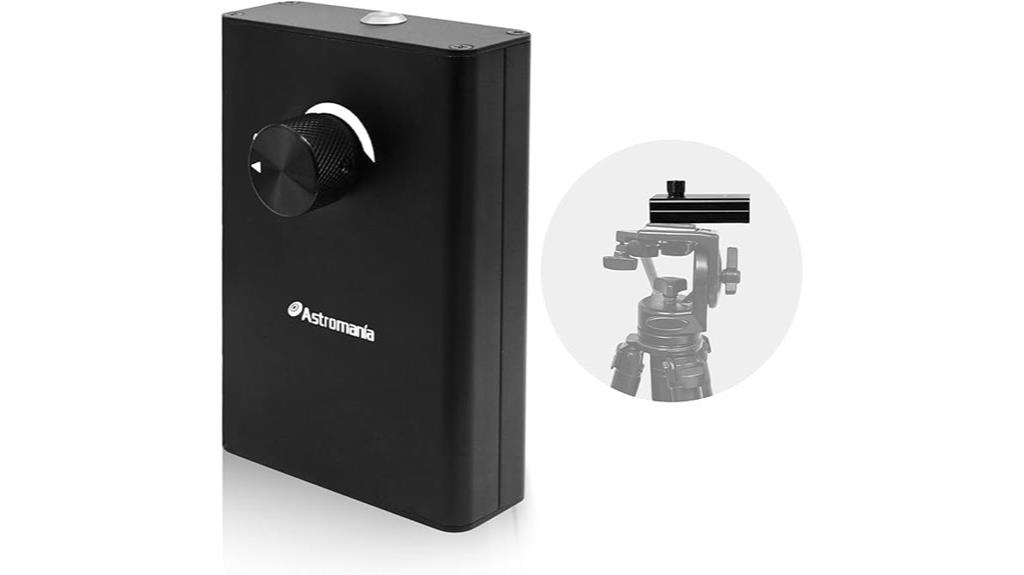
The Astromania Artificial Star for Telescope Testing and Collimation stands out thanks to its precisely engineered 50µm pinhole, which delivers highly accurate results during alignment procedures. Its metal housing guarantees durability, avoiding plastic components that can warp or break. The dimmable brightness feature allows me to adjust contrast for different testing scenarios, making it versatile. Powered by two AA batteries, it’s portable and easy to set up with the included photo tripod connector and brass extension. Weighing just 4.6 ounces, it’s lightweight and convenient. This tool has earned high praise from users, helping me achieve precise collimation effortlessly.
Best For: amateur astronomers and telescope enthusiasts seeking precise testing and collimation tools for their optical setups.
Pros:
- Precisely engineered 50µm pinhole for accurate alignment results
- Durable metal housing ensures long-lasting use and resistance to warping
- Dimmable brightness feature allows versatile contrast adjustments for various testing scenarios
Cons:
- Requires two AA batteries (not included), adding to setup considerations
- Slightly higher weight compared to plastic models, though still portable
- Limited to use with tripods that accommodate the 1/4-inch female thread connection
Factors to Consider When Choosing Telescope Collimation Tools

When choosing a collimation tool, I consider how well it works with my telescope type and how easy it is to use. I also look at how precise the adjustments can be and whether the build feels durable. Finally, I weigh the price against the value it offers to guarantee I get the best fit for my budget.
Compatibility With Telescope Type
Choosing the right collimation tool depends heavily on your specific telescope type, as compatibility guarantees accurate alignment and peak performance. Different telescopes, like Newtonians, Schmidt-Cassegrains, or refractors, often require specialized tools. For example, Cheshire eyepieces are typically used for Newtonian mirrors, while laser collimators may work across various types with the right adapters. It’s vital to verify the size and fitting—whether 1.25-inch or 2-inch focusers—to guarantee the tool fits your telescope’s focuser or diagonal. Some collimation tools are designed exclusively for reflectors, while others suit refractors or compound telescopes; always check the manufacturer’s specifications. Ensuring compatibility helps achieve proper collimation and peak viewing performance.
Ease of Use
Ease of use is a crucial factor when selecting a telescope collimation tool, especially if you’re new to astronomy. A straightforward setup and simple operation make the process less frustrating. Tools with clear, step-by-step instructions and minimal calibration steps are more user-friendly. Features like adjustable brightness levels and intuitive adjustment mechanisms help streamline collimation, saving time and effort. Shorter, well-designed tools often provide better visibility of alignment markers, making precise adjustments easier. Compatibility with standard focusers and minimal need for additional calibration also enhance usability across different skill levels. Overall, choosing a tool that’s easy to operate allows you to focus more on observing rather than struggling with complex adjustments, making your stargazing experience more enjoyable and productive.
Adjustment Precision
The adjustment precision of a collimation tool is essential because it directly impacts how accurately you can align your telescope’s optical components. Precise tools with fine adjustment mechanisms, like calibrated dials or multi-point screws, enable small, controlled movements, resulting in better alignment. The number and placement of adjustment points—such as three positioned at 120°—also influence your ability to make precise corrections. Fully adjustable tools that can be calibrated after purchase help maintain accuracy over time, especially if they shift during transport or use. Additionally, consider the resolution limit of the adjustment mechanism, often measured in micrometers or arcminutes, which defines the smallest adjustment you can make. Higher precision tools ultimately lead to sharper images and improved telescope performance.
Durability and Build
A sturdy build is vital for a telescope collimation tool because it guarantees reliable performance over time. I look for tools made from high-quality materials like anodized aluminum or CNC-machined metal, as these resist wear and environmental stress better. Metal construction ensures the tool won’t warp or bend with temperature changes, maintaining consistent accuracy. The robustness of the build also reduces the risk of mechanical failure due to wear and tear, which is essential for long-term use. Sealed adjustment mechanisms are a bonus—they keep dust, moisture, and debris out, preserving calibration accuracy. Investing in a well-made, durable collimation tool means it’ll last longer, saving me from frequent replacements or repairs, and providing reliable performance night after night.
Price and Value
Choosing the right telescope collimation tool involves balancing cost and features to get the best value for your money. Prices vary widely—simple Cheshire eyepieces are affordable, while advanced laser collimators can be pricier. If you’re a casual observer, an inexpensive tool might suffice, but serious astronomers can benefit from higher-priced options that offer better durability, accuracy, and ease of use, providing long-term value. Comparing features—like adjustable brightness, calibration options, and compatibility—helps determine if the higher cost is justified. Customers often find that budget tools work well for beginners, but professionals or dedicated amateurs may find premium tools worth the investment. Finally, price matching and reading reviews can help you secure the best deal and ensure you’re getting good value for your money.
Frequently Asked Questions
How Often Should I Realign My Telescope for Optimal Viewing?
I recommend realigning your telescope every few weeks, especially if you use it frequently or transport it often. Weather changes, bumps, or temperature fluctuations can throw off your alignment, so regular checks help guarantee sharp images. If you’re observing planets or deep-sky objects, I suggest collimating before each session to get the best view. Staying consistent with this routine keeps your telescope performing at its peak.
Can Collimation Tools Be Used for All Telescope Types?
Yes, collimation tools can generally be used for all telescope types, but it’s important to choose the right one. For example, laser collimators work well for reflectors, while sight tubes are often better for Dobsonians. Refractors usually need less frequent collimation, but if you do need to realign, specific tools designed for that type will give you the best results. Always check compatibility before purchasing.
What Is the Ideal Environmental Condition for Collimation?
Imagine perfect clarity in your view—achieving it starts with the right environment. I find that the ideal condition for collimation is a stable, cool, windless night with minimal temperature fluctuations. This reduces mirror and lens expansion or contraction. I avoid collimating in high humidity or during rapid temperature changes, because these factors cause distortion. Clear, calm, and consistent conditions help me align my telescope precisely, ensuring sharp, stunning images every time.
How Do I Know if My Collimation Is Accurate?
You’ll know your collimation is accurate when your star images appear sharp and pinpoint through your eyepiece, especially during high magnification. I check this by focusing on a bright star and watching for a tiny, steady point without any blurring or coma. If the star’s image shifts or flares, I re-collimate until the star remains perfectly centered and symmetrical, ensuring ideal alignment for clear, crisp views.
Are There Digital Alternatives to Traditional Collimation Tools?
Sure, digital collimation tools are a thing now, and honestly, they make traditional tools seem almost quaint. I’ve used electronic collimators and software apps that analyze star images for perfect alignment. They’re quick, precise, and honestly, a bit addictive. While I still appreciate classic methods, these digital options offer a modern edge that takes the guesswork out of collimation, making star-gazing more enjoyable and less frustrating.
Conclusion
Choosing the right telescope collimation tool is like wielding a wizard’s wand—precision transforms your stargazing. Whether you’re aligning a Newtonian or testing with an artificial star, these tools are your trusty sidekicks in ensuring sharp, clear views. Think of it as tuning your telescope’s “musical instrument” for a symphony of stars. Invest wisely, and you’ll enjoy celestial concerts that rival even the most legendary nights in history.
